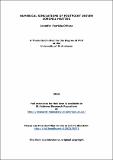Files in this item
Numerical simulations of footpoint driven coronal heating
Item metadata
| dc.contributor.advisor | De Moortel, Ineke | |
| dc.contributor.author | O'Hara, Jennifer | |
| dc.coverage.spatial | 199 | en_US |
| dc.date.accessioned | 2016-05-25T15:43:15Z | |
| dc.date.available | 2016-05-25T15:43:15Z | |
| dc.date.issued | 2016-06-24 | |
| dc.identifier | uk.bl.ethos.687024 | |
| dc.identifier.uri | https://hdl.handle.net/10023/8871 | |
| dc.description.abstract | Magnetic field permeates the solar atmosphere and plays a crucial role in the dynamics, energetics and structures observed. In particular, magnetic flux tubes provide the structure for coronal loops that extend from the solar surface into the corona. In this thesis, we present 3D numerical simulations examining the heating produced by reconnection between flux tubes driven by rotational footpoint motions. The basic model consists of two, initially aligned, flux tubes that are forced to interact by rotational driving velocities on the flux concentrations on the boundaries. A single, twisted current layer is created in the centre of the domain and strong, localised heating is produced. We extend this model by altering the number, distribution and strength of the sources, while maintaining the same total magnetic flux on the boundaries. The dynamical evolution and the resultant magnitude, distribution and timing of the heating events are examined for the different flux distributions. In all cases, the magnetic field is stressed by the boundary motions and a current grows within the domain. A comparison of cases with two and four sources shows that there are more locations of current concentrations, but with reduced maximum current density values, for the four source case. This produces weaker reconnection and less efficient heating. In addition, for the case with two sources, we also consider the effect of splitting up one of the sources into many smaller flux fragments. The evolution and heating are shown to be very similar to the two source case. The impact of increasing the strength of the background field between the flux tubes is also examined and we find that it delays and increases the strength of the heating, although by how much depends on the distribution of the flux sources. | en_US |
| dc.language.iso | en | en_US |
| dc.publisher | University of St Andrews | |
| dc.subject | Magnetohydrodynamics | en_US |
| dc.subject | Sun--Corona | en_US |
| dc.subject | Magnetic fields | en_US |
| dc.subject.lcc | QB539.M23O5 | |
| dc.subject.lcsh | Sun--Corona | en_US |
| dc.subject.lcsh | Magnetohydrodynamics--Mathematical models | en_US |
| dc.subject.lcsh | Magnetic fields--Mathematical models | en_US |
| dc.subject.lcsh | Magnetic reconnection--Mathematical models | en_US |
| dc.title | Numerical simulations of footpoint driven coronal heating | en_US |
| dc.type | Thesis | en_US |
| dc.contributor.sponsor | Science and Technology Facilities Council (STFC) | en_US |
| dc.type.qualificationlevel | Doctoral | en_US |
| dc.type.qualificationname | PhD Doctor of Philosophy | en_US |
| dc.publisher.institution | The University of St Andrews | en_US |
This item appears in the following Collection(s)
Items in the St Andrews Research Repository are protected by copyright, with all rights reserved, unless otherwise indicated.

